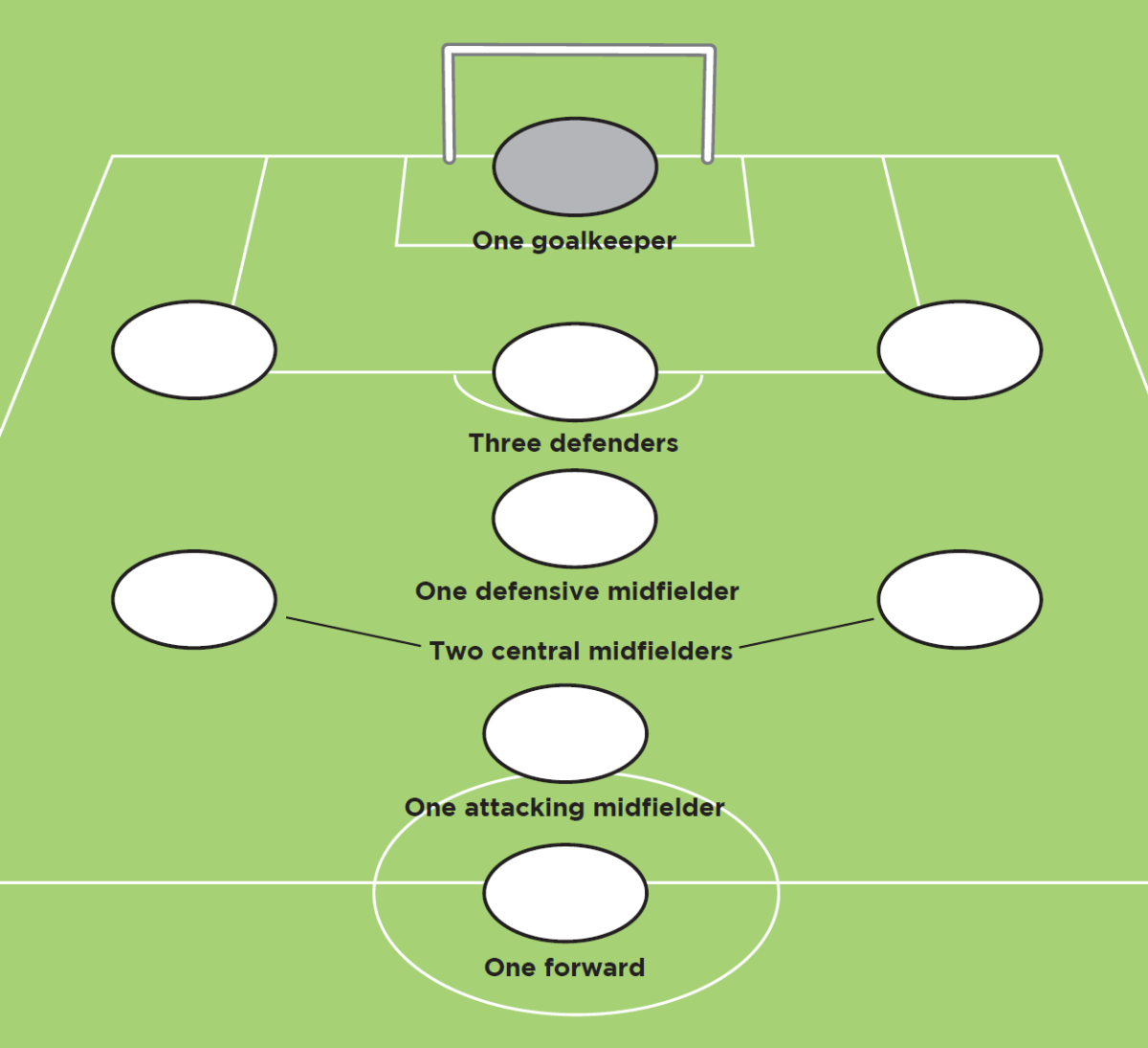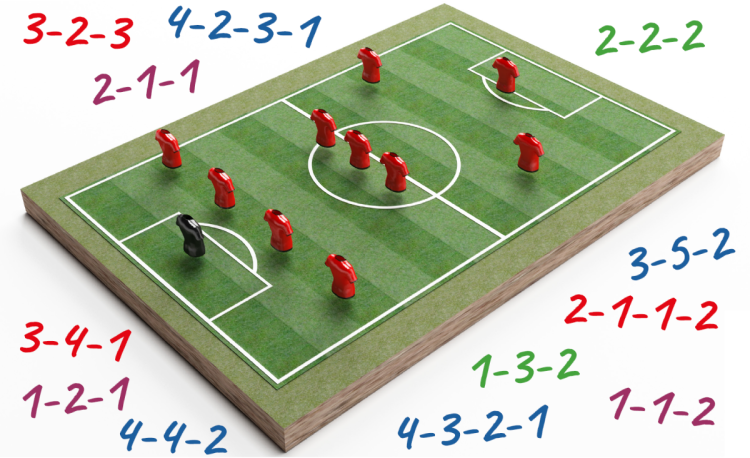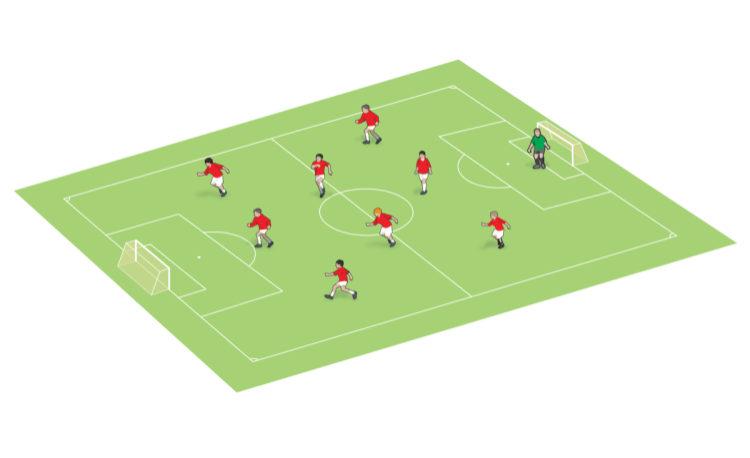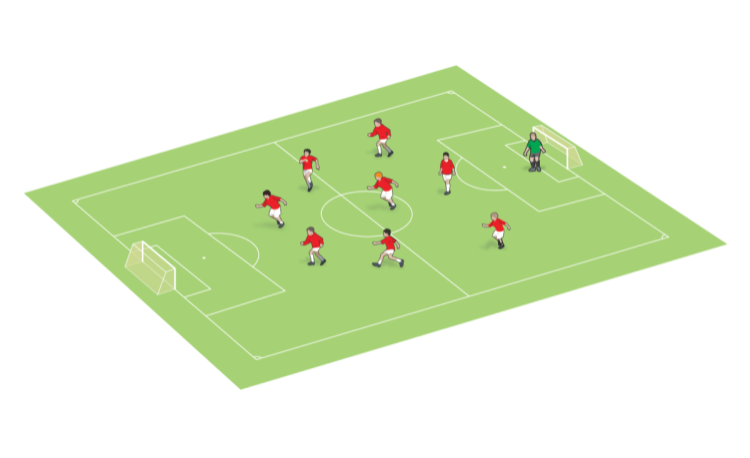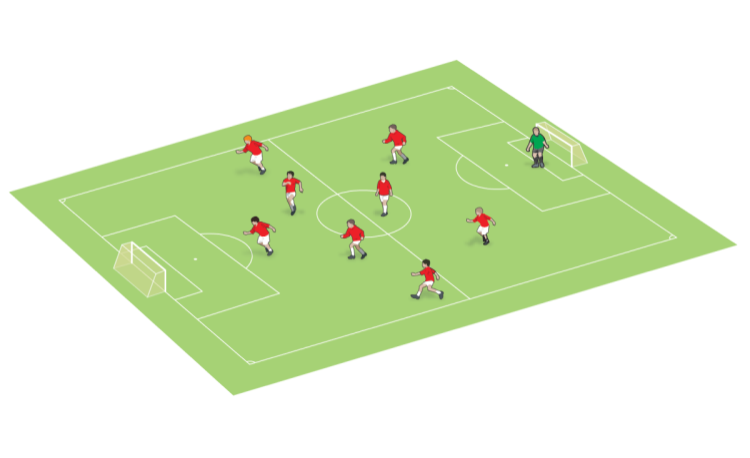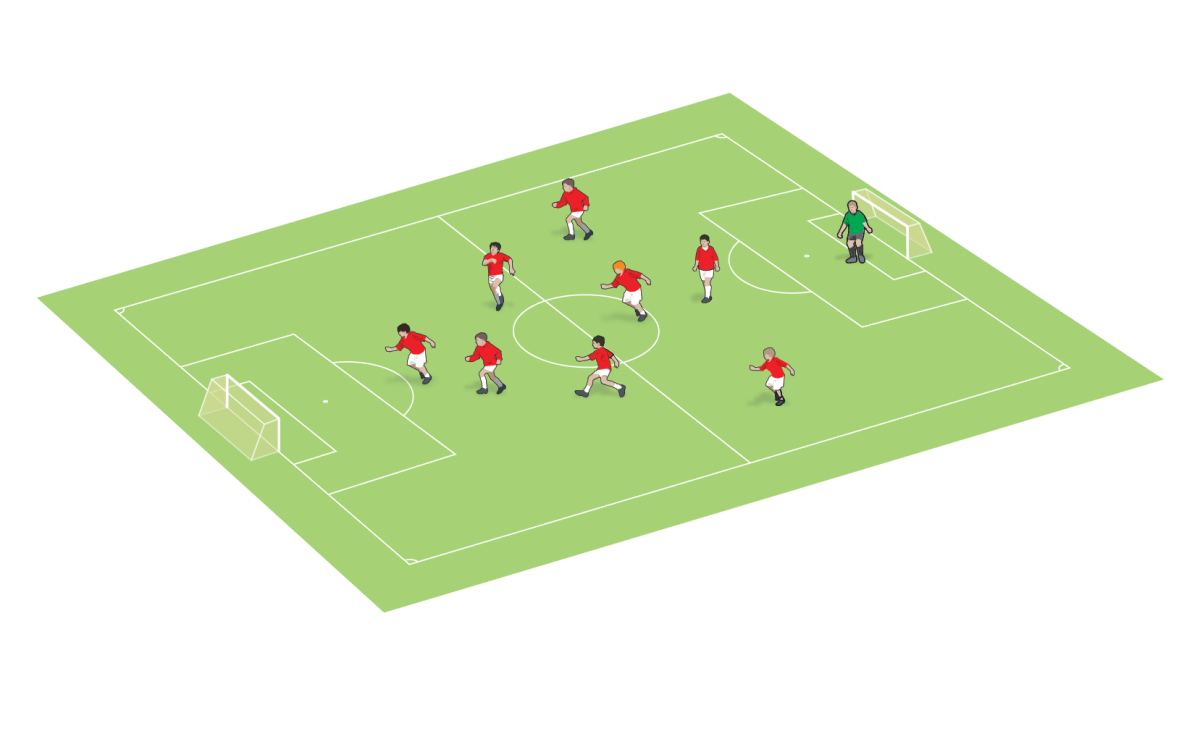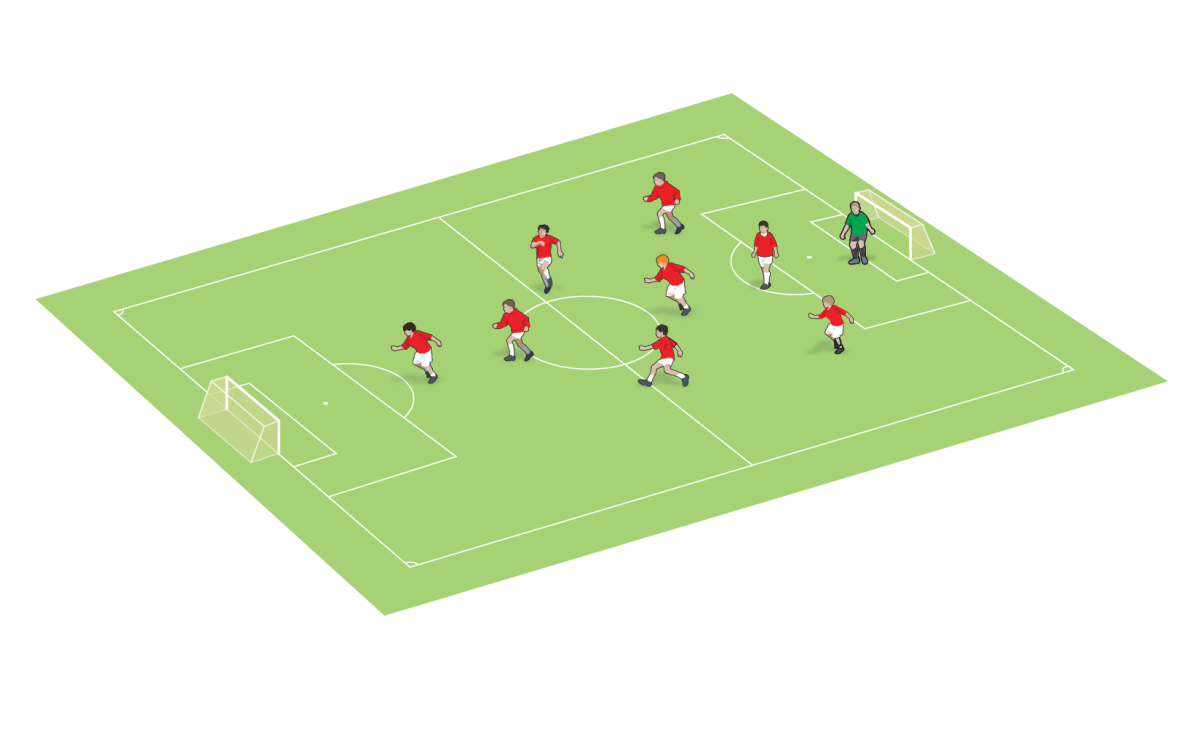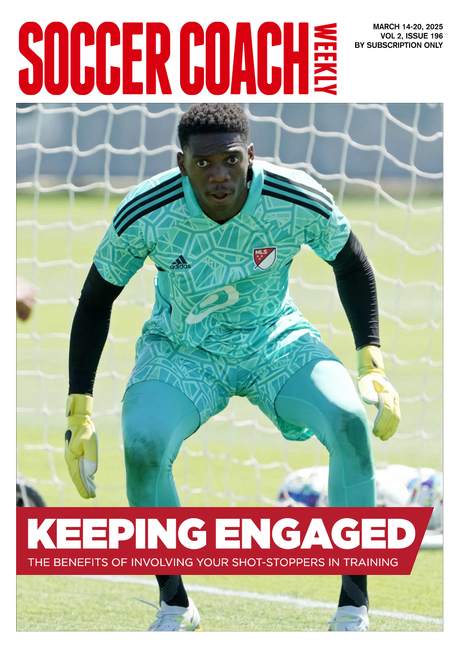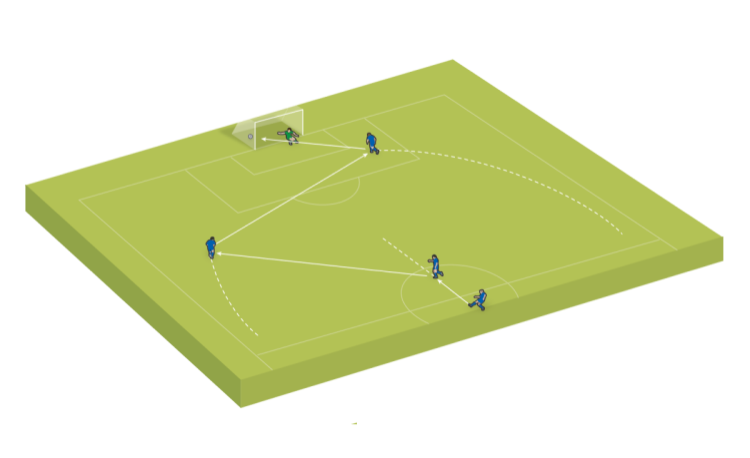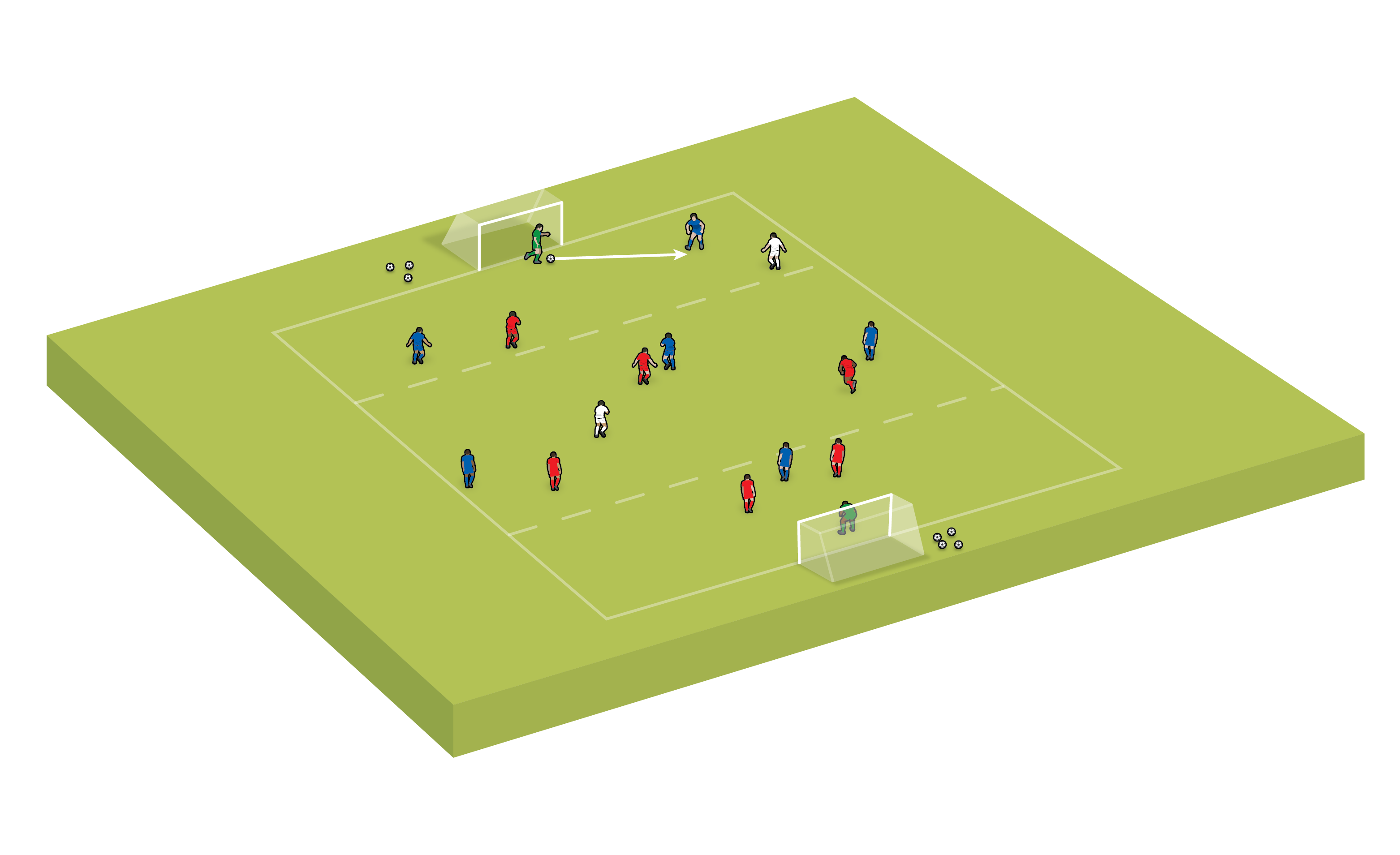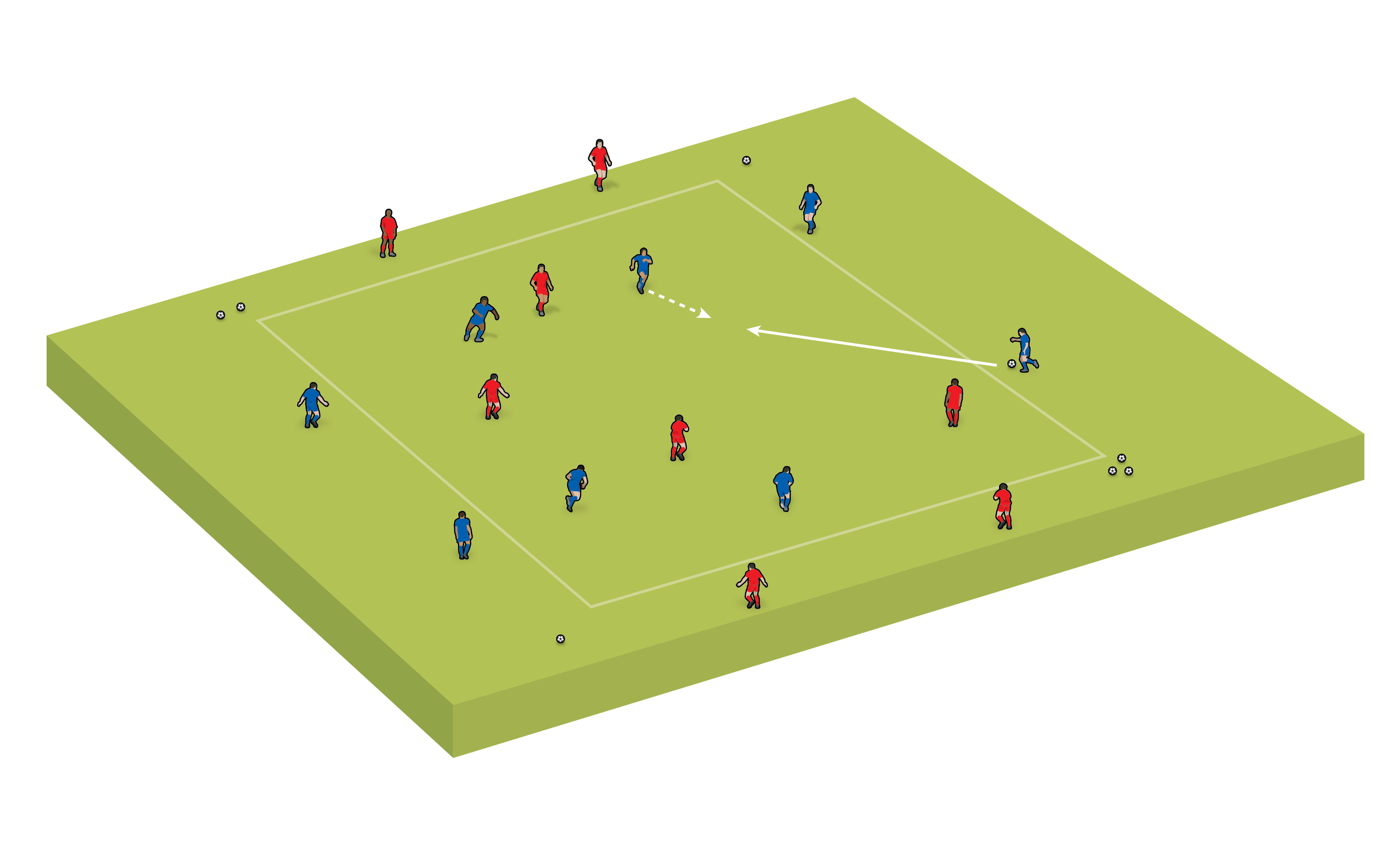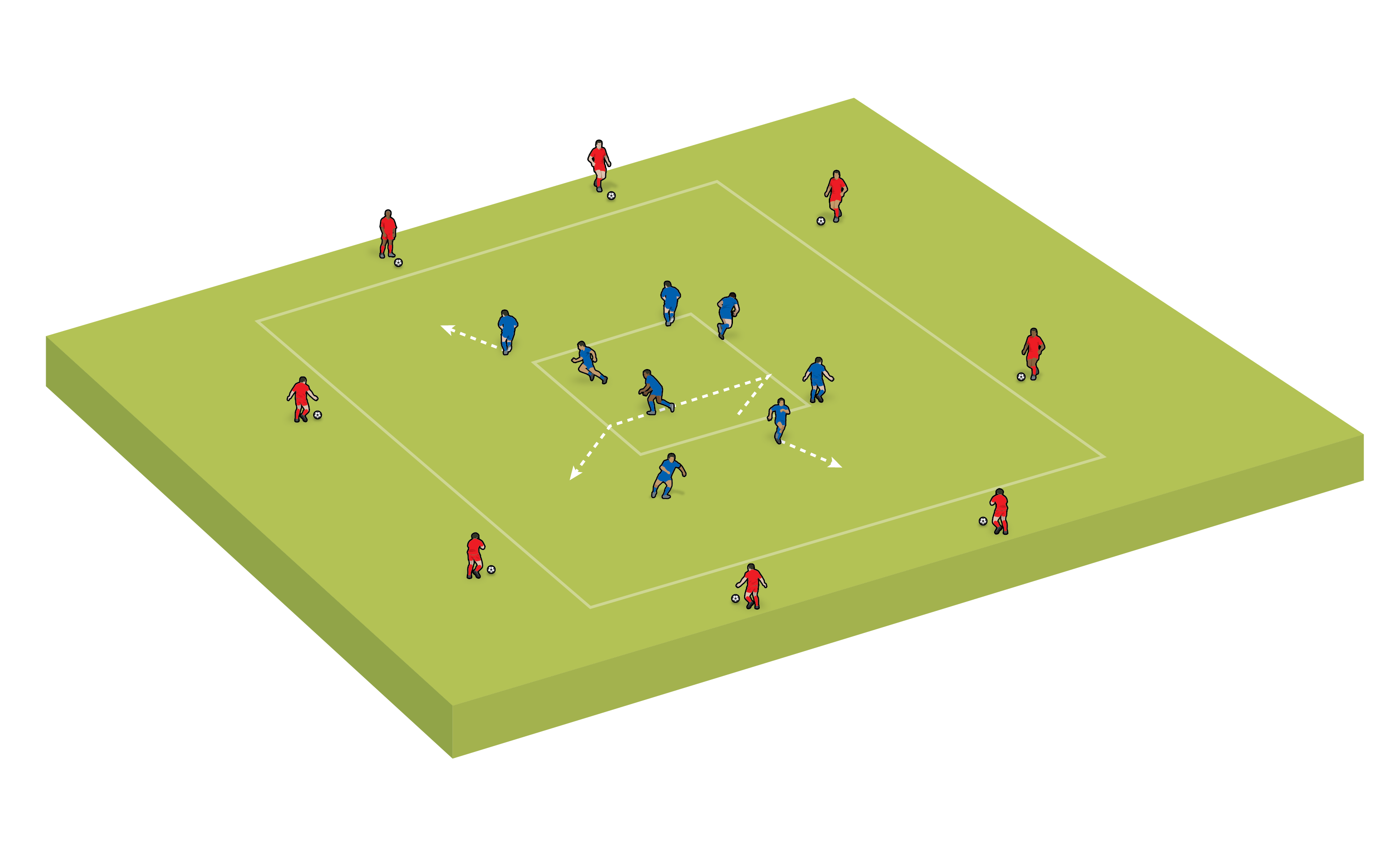9-a-side formation: 3-1-2-1-1
Why choose this 9v9 formation? Review the pros and cons, in possession and out of possession principles, and each position
Progresses from: 2-1-2-1 (7-a-side)
Progresses to: 4-3-2-1 (11-a-side)
PROS OF THIS FORMATION |
CONS OF THIS FORMATION |
|
|
|
|
|
|
9v9 3-1-2-1-1 - IN-POSSESSION SUMMARY
IN-POSSESSION PROS |
IN-POSSESSION CONS |
|
|
|
|
|
|
|
3–1–2-1-1 IN-POSSESSION - BY POSITION
Goalkeeper
The lack of options in wide areas means the goalkeeper will often need to play centrally, which means the accuracy and weight of their passes will need to be precise.
Because the team is heavily weighted towards the central area of the pitch, the opposition will also look to place most of their players centrally. This could open up opportunities to play the ball into wide areas; it is just a matter of when and how the goalkeeper does this.
It is unlikely that the keeper will be able to do it when they are initially in possession, whether from a set piece or receiving it from a team-mate. Their first pass will probably still need to be played centrally, encouraging the opposition players to position themselves in the middle of the pitch, thus opening up the wide areas.
To exploit this space, the wide defenders will need to position themselves higher up the pitch, otherwise they will be sat too deep, giving the opposition players time to get across and prevent them from progressing forward.
If the wide defenders are positioned higher up the pitch, the pass to get the ball to them will need to be a diagonal one, either driven or lofted.
Central defender
The central defender plays an important role in supporting the goalkeeper with their distribution.
When the keeper plays their first pass into the central area, it will often be the central defender who receives the ball.
Therefore, they will need to complete a number of technical actions effectively to ensure they give their goalkeeper or themselves the best possible chance to complete the next pass successfully.
In the first instance, the central defender will need to receive the ball while under pressure.
When they do, they are likely to either bounce the ball straight back to the goalkeeper, or control it before they pass it. If they look to control the ball, they will first need to shield or protect it from the opponent applying the pressure.
To do this, they will need to adopt a side-on stance, and then control and hold on to the ball with the foot furthest away from the defender. They should also have their knees bent, and use their arm to hold their opponent back.
The pass, whether played first time or after a touch, needs to be in exactly the right area, to give the goalkeeper all the help possible to execute their next pass – likely a challenging diagonal one – effectively.
Related Files
- The central midfielders must identify the right moment to move the ball away from congestion
- The attacking midfielder and striker will need to have a good relationship, understanding when to work together and when to do the opposite to their partner
- The central defender must have the right body shape to retain the ball under pressure
- Defensive midfielder can act as an option to switch play or as a ’safety net’ to pass back to
- Wide defenders are likely to have space ahead of them to drive forward with the ball
- The goalkeeper will often need to play into central areas
Wide defenders
If the goalkeeper is to play long, diagonal passes into the wide areas, the wide defenders need to be positioned in this part of the pitch.
There are also some key technical components that they will need to execute. If the pass from the keeper is a lofted one, the player will need to control the ball using their chest, thigh or foot, while elevated from the ground.
This type of control is something they will have limited experience of from the smaller formats of the game.
If the opposition looks to mark the two defenders in these wide positions, then they will have done their job in creating space for their team-mates who are positioned centrally.
It is likely, though, that they won’t be marked, because the opposition will probably be concerned with the number of players the team has in the central area of the pitch.
So, once the wide defenders have received a pass, they will have space ahead of them. They then have the opportunity to drive forward with the ball.
As well as getting the opportunity to improve their ability to travel with the ball at speed, the wide defenders will also get to practise passing the ball with the inside of their foot while not breaking their stride.
This helps them to disguise a pass, which is needed when the space ahead of them is closed off.
Defensive midfielder
No matter the formation, there will always be certain requirements that come with the defensive midfielder role.
They will always need to connect the defensive and midfield units, to help the team progress the ball up the pitch; they will look to help the team switch the ball from one side of the pitch to the other; and they will position themselves so that the more advanced midfielders can play back to them, if they need a ’safe’ option.
"Once the wide defenders receive a pass, they will have space ahead of them..."
In this formation, with none of the midfielders or forwards providing width, the defensive midfielder can switch play by passing to the wide defender on the opposite side of the pitch.
This pass should be played in front of their team-mate, to encourage them to step into it. This provides the wide defender with some momentum that they can then use to move forward with the ball.
Therefore, the weight and area of pass needs to be exactly right, so the wide defender does not have to slow down or readjust in any way.
Central midfielders
Getting the correct distance between themselves and a number of their team-mates is crucial to playing the central midfield role.
Because the centre of the pitch is so congested, the midfielders will need to ensure they don’t take up each other’s space, while also making sure that they are in a position to support the player on the ball.
To do this successfully, they will need to do a number of things effectively, including scanning and combining with their team-mates, which will need good control of the ball and the ability to play with limited touches.
There is also an opportunity for these players to develop their decision-making and to recognise how to make full use of an advantage they may have over the opposition.
They can take advantage of having extra players in the central area by keeping the ball in this area. This will attract opposition players to come into the centre to try to win possession. Large spaces in other areas of the pitch, such as the wide areas, can then be exploited.
For this to work, the central midfielders need to identify the right moment to move the ball away from the congestion and into the space.
To attract the opposition players, the ball will need to be moved quickly with short, accurate passes, before a long pass is executed.
Attacking midfielder
This player will need to have a good relationship with the lone striker, understanding when to work closely together and when to do the opposite to their partner.
For instance, they might work closely together when one of them is holding up the ball and looking for support, or work in reverse when one comes short to receive the ball, while the other player goes long to help create more space.
Playing in this role will naturally encourage the player to find pockets of space between the opposition’s defensive and midfield units. The key to this is recognising when some form of movement is required and when to stand still.
As the ball is moved around the pitch, the opposition will naturally move with it in an attempt to remain compact, so that they cannot be penetrated.
The aim of the attacking midfielder is to try to find the new spaces that occur as the pictures within the game continuously change.
Once they have found the space, their body shape is very important. They need to be able to see as much of the pitch as possible, in particular where the ball is coming from and where they want to play; ideally, forward.
Then, when they have the ball, the attacking midfielder needs to be brave, confident and creative.
As coaches, we need to provide them with an environment and the encouragement that allows them to do this.
"When they have the ball, the attacking midfielder needs to be brave and creative..."
Forward
Playing on their own means the forward will, at times, be very isolated.
When support does arrive, it will usually be from behind. It is, therefore, likely that, when passing the ball to a team-mate, the forward’s pass will be played backwards. So, instead of looking to play the ball in behind, team-mates will often play into the centre-forward’s feet.
This means they are often required to receive the ball with their back to goal, so will need to shield it and retain possession until they can lay it off to a team-mate.
Once the ball has been passed to a team-mate, the striker will need to think about their movement; not only so that they do not take up the space of their team-mate who has just received the ball, but also to give that same player a possible passing option.
Often in these situations, players will look to run forwards, towards the opponents. Though this tends to be the correct decision, as it stretches the pitch and provides the player on the ball with an option ahead of them, the execution of the run needs to be more effective.
A straight run to receive a straight pass usually does not work. The striker should instead try to make a straight run to receive a diagonal pass, or a diagonal run to receive either a straight or diagonal pass.
They will need to consider where their team-mate with the ball is positioned and, from that, decide which type of run is the best one to make. When making the run, they need to consider the exact pathway they will take and their body shape, allowing them to see the ball and stay onside.
9v9 3-1-2-1-1 - OUT-OF-POSSESSION SUMMARY
OUT-OF-POSSESSION PROS |
OUT-OF-POSSESSION CONS |
|
|
|
|
|
3-1-2-1-1 OUT-OF-POSSESSION - BY POSITION
Goalkeeper
As the formation naturally encourages the team to be compact and narrow, the opposition will look to penetrate by going round, rather than through or over.
It is therefore likely that the goalkeeper will need to deal with balls coming into the penalty box from wide areas.
When transitioning from attack to defence, teams in this formation often find it difficult to get themselves organised and back into shape quickly, giving their opponents opportunities to counter-attack centrally.
In these situations, the goalkeeper must consider their positioning and their reaction to the team losing the ball.
Ideally, they will start quite high, so they are in a position to intercept the pass should the opposition look to play direct.
Here, their judgement is really important; if they get it wrong, they are likely to find themselves in a position where they are no longer able to protect the goal.
They must also consider the speed at which the opposition will attack, and the probable overload advantage they will have, analysing their position and those of their opponents.
Quick feet will be needed to change their position, for instance to get across the goal or to rush out and close down angles.
Central defender
The central defender will need to be the organiser and the focal point. It is key that they do not vacate the central part of the pitch.
They will also take the lead in organising the other defenders, in particular altering their positioning as the ball is moved around the pitch.
If the ball is switched by the opposition, the central defender’s movement from one side of the pitch to the other will help push one of the wide defenders across with them, and drag the other one over at the same time.
In a similar way, they will move the defensive unit up and down the pitch, depending on the position of the ball and the situation of play.
The central defender will also need to alter their position slightly as the wide defenders move into different areas of the pitch to engage opposition players with the ball.
They will also need to deal with crosses coming into the box and have to engage in a number of 1v1 battles with opposition players. This will include defending from behind and face-to-face.
Finally, the central defender will also need to deal with the movement of the opposition’s forward players.
They will need to decide when they should go with the run and when they should pass them on to a team-mate or let them run offside.
All of this requires decisive leadership skills.
- The central midfielders need to stop the opposition from playing through the team in central areas
- The forward has to make a decision on whether to initiate the press
- Most of the wide defenders’ tasks will be done 1v1
- The attacking midfielder must have good awareness out of possession, and be ready to make quick decisions
- The defensive midfielder must read the game and predict what is going to happen next
- The goalkeeper will need to deal with balls coming into the penalty box from wide areas
- It is key that the central defender does not vacate the central part of the pitch
Wide Defenders
The wide defenders must cover the spaces in the wide areas. They will have to complete a range of defensive tasks, and most of these will be performed 1v1.
These will include closing down any opponents that have the ball in wide areas and engaging in races for the ball when a pass is played into space, rather than to feet.
When there is an opportunity, they will need to try to get in between their opponent and the ball, so that they can do more than just tackle a player, they can actually win possession.
But before they engage in the task of defending and trying to win the ball, they will need to cover quite a lot of ground quickly; how they do this will play an important part in determining whether or not they are successful.
When closing down an opponent in a wide area, it is essential the defender recognises that they cannot run to where the player is positioned. It is not about where they are now, but where they are going to be.
Therefore, the first part of the process is the defender making the decision about where to run to and the pathway they follow to get there. Can they run directly to where they need to be? Or, do they need to arc their run to cut off a passing option?
Then, once they get closer to their opponent, it is essential that they do not over-commit and that they slow down.
The large steps they used to cover the ground quickly now need to be reduced to smaller steps, so that they can quickly react to any developing changes in the situation, such as the opponent suddenly changing direction or spotting an opportunity to win the ball.
"A defensive midfielder will need to identify which area of the pitch is most in danger..."
Defensive midfielder
The main role of a defensive midfielder stays the same, no matter the formation. They will try to protect the defensive line by positioning themselves to intercept a pass from the opposition, who are trying to play into their front line.
They will also try to win the ball back quickly when the team lose possession in their opponent’s half, to prevent the other team from counter-attacking.
Both of these tasks require them to be in the correct position by reading the game and predicting what is going to happen next.
In this formation, it is likely the wide defenders will have to go into the wide areas throughout the game, so the defensive midfielder will need to react in these moments and make important decisions.
When one of the three defenders goes into a wide position to engage an opponent, the defensive midfielder is likely to have two choices: do they support their team-mate and provide cover? Or do they look to fill the space that the defender has vacated?
The correct decision will depend on a number of factors, including the number of opponents in the wide area and the action of the closest central midfielder.
The defensive midfielder will need to identify which area of the pitch is most in danger, in terms of there being too much space and not enough cover.
Central midfielders
They need to stop the opposition from playing through the team in central areas.
This involves positioning themselves to fill in spaces that prevent the opposition from playing through them, while being close enough to their opponent so they can close them down should they receive the ball.
In addition, they will need to win their individual battles when they come up against a midfielder from the opposition team.
This includes their ability to intercept the ball; they will need to judge whether they can get to the ball ahead of the intended target. If they get this wrong, they are likely to find themselves out of position and the wrong side of the ball.
In this particular formation, there will be times when the central midfielders might need to leave their usual position and push on into a more forward position.
Because this formation has an attacking midfielder playing behind the striker, it is possible that, on occasion, one of the central midfielders may be in a better position to close down an opponent in a deeper position, such as a centre-back.
When making the decision to do this, they will need to take a number of things into consideration, including the distance they will need to cover, and analysing the speed, accuracy and quality of pass as it is played to the opponent they are going to close down.
They should also consider the line in which they approach, so that it reduces the passing options available to the player with the ball.
Attacking midfielder
Because the attacking midfielder is situated directly behind the striker, they must have good awareness out of possession, and be ready to make quick decisions.
When a team uses a formation that has two strikers, they are usually allocated a side of the pitch they will play, making it easier for them to work together when the team is defending.
But when a team plays with an attacking midfielder and a striker, the set-up becomes less structured, and there is more of a possibility that there will be some confusion between the two players.
In some instances, the attacking midfielder will need to take the lead from the centre forward, identifying the action their team-mate is taking and then working out where they need to position themselves to support them.
"The first decision the forward has to make is whether or not to initiate the press..."
It could be that the striker closes down a centre-back in possession of the ball. In this situation, the attacking midfielder would need to move into a central area of the pitch to protect the space, while also being in a position to get across the pitch to engage the other defender should the ball be played to them.
Or, it could be that they see the striker close down an opponent, creating an opportunity to win the ball back, and look to support their team-mate quickly.
Forward
The first decision the forward has to make out of possession is whether or not to initiate the press.
They will need to assess where their team-mates are situated, and whether they are in a position to join in with the press. If the striker presses, and no-one is close enough to help them, the opposition will be able to play past them easily, which means there is then one less player between the ball and the goal.
So, the striker essentially makes the decision about whether the whole team should press. This is aided by identifying certain ‘triggers’ that will encourage the press, such as a touch or pass that is not as effective as the opponent would have liked.
If they do decide to press, they again need to analyse where their team-mates are positioned, so they know where to try and force their opponent to play. They need to approach the player on the ball in a way that makes them play in a certain direction.
If the decision is not to press, the forward needs to fall back and help their team-mates to become compact and prevent the opposition from playing through them.
To do this, they must analyse the pitch again and identify the space that needs filling.
Newsletter Sign Up
Coaches Testimonials

Gerald Kearney, Downtown Las Vegas Soccer Club

Paul Butler, Florida, USA

Rick Shields, Springboro, USA

Tony Green, Pierrefonds Titans, Quebec, Canada
Subscribe Today
Discover the simple way to become a more effective, more successful soccer coach
In a recent survey 89% of subscribers said Soccer Coach Weekly makes them more confident, 91% said Soccer Coach Weekly makes them a more effective coach and 93% said Soccer Coach Weekly makes them more inspired.
*includes 3 coaching manuals
Get Weekly Inspiration
All the latest techniques and approaches
Soccer Coach Weekly offers proven and easy to use soccer drills, coaching sessions, practice plans, small-sided games, warm-ups, training tips and advice.
We've been at the cutting edge of soccer coaching since we launched in 2007, creating resources for the grassroots youth coach, following best practice from around the world and insights from the professional game.
